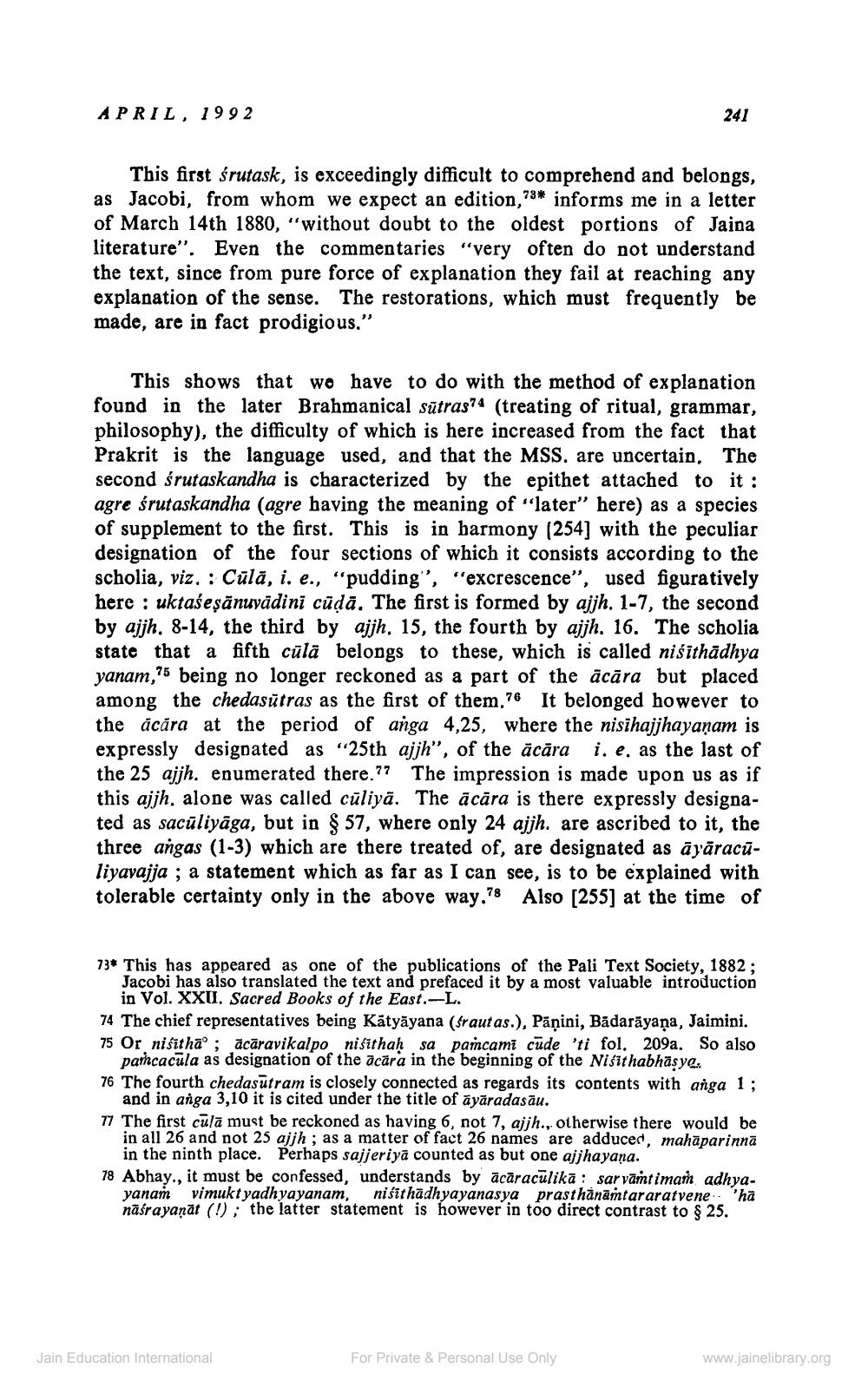________________
APRIL, 1992
This first śrutask, is exceedingly difficult to comprehend and belongs, as Jacobi, from whom we expect an edition,73* informs me in a letter of March 14th 1880, "without doubt to the oldest portions of Jaina literature". Even the commentaries "very often do not understand the text, since from pure force of explanation they fail at reaching any explanation of the sense. The restorations, which must frequently be made, are in fact prodigious."
241
This shows that we have to do with the method of explanation found in the later Brahmanical sutras74 (treating of ritual, grammar, philosophy), the difficulty of which is here increased from the fact that Prakrit is the language used, and that the MSS. are uncertain. The second śrutaskandha is characterized by the epithet attached to it: agre śrutaskandha (agre having the meaning of "later" here) as a species of supplement to the first. This is in harmony (254] with the peculiar designation of the four sections of which it consists according to the scholia, viz.: Cūlă, i. e., "pudding", "excrescence", used figuratively here: uktaseṣānuvādinī cūḍā. The first is formed by ajjh. 1-7, the second by ajjh. 8-14, the third by ajjh. 15, the fourth by ajjh. 16. The scholia state that a fifth cula belongs to these, which is called nisithādhya yanam,75 being no longer reckoned as a part of the acara but placed among the chedasütras as the first of them.76 It belonged however to the acăra at the period of anga 4,25, where the nisihajjhayaṇam is expressly designated as "25th ajjh", of the ācāra i. e. as the last of the 25 ajjh. enumerated there." The impression is made upon us as if this ajjh. alone was called culiya. The acara is there expressly designated as saculiyaga, but in § 57, where only 24 ajjh. are ascribed to it, the three angas (1-3) which are there treated of, are designated as āyāraculiyavajja; a statement which as far as I can see, is to be explained with tolerable certainty only in the above way." Also [255] at the time of
78
73* This has appeared as one of the publications of the Pali Text Society, 1882; Jacobi has also translated the text and prefaced it by a most valuable introduction in Vol. XXII. Sacred Books of the East.-L.
74 The chief representatives being Kätyāyana (śrautas.), Pāņini, Bādarāyaṇa, Jaimini. 75 Or nisitha; acaravikalpo nisithaḥ sa pamcami cude 'ti fol. 209a. So also pancacula as designation of the acara in the beginning of the Nisithabhāṣya.
76 The fourth chedasutram is closely connected as regards its contents with anga 1; and in anga 3,10 it is cited under the title of ayaradasāu.
77 The first cula must be reckoned as having 6, not 7, ajjh., otherwise there would be in all 26 and not 25 ajjh; as a matter of fact 26 names are adduced, mahāparinna in the ninth place. Perhaps sajjeriya counted as but one ajjhayaṇa.
78 Abhay., it must be confessed, understands by acaraculika sarvämt imam adhyayanam vimukt yadhyayanam, nisithadhyayanasya prasthanamtararatvene 'ha nasrayaṇāt (!); the latter statement is however in too direct contrast to § 25.
Jain Education International
For Private & Personal Use Only
www.jainelibrary.org




